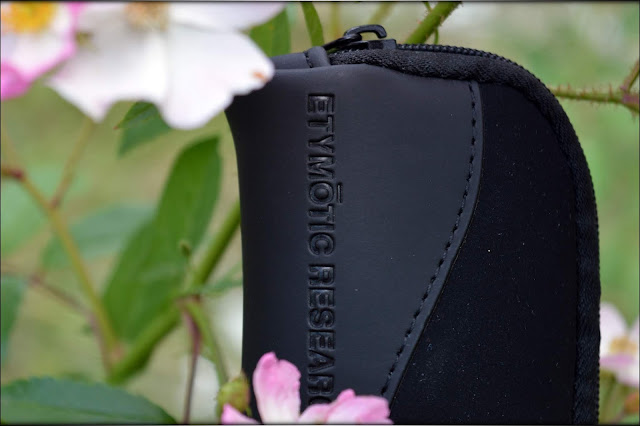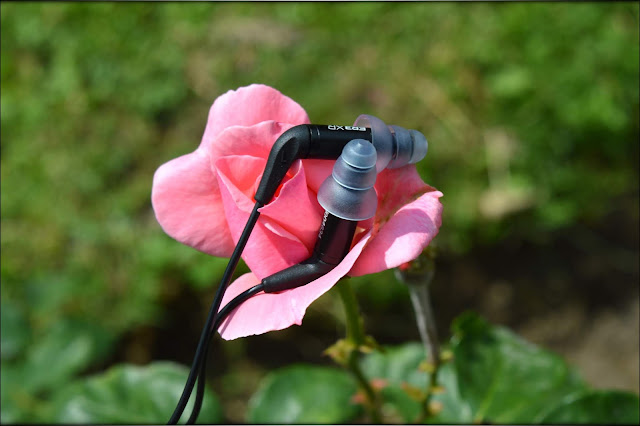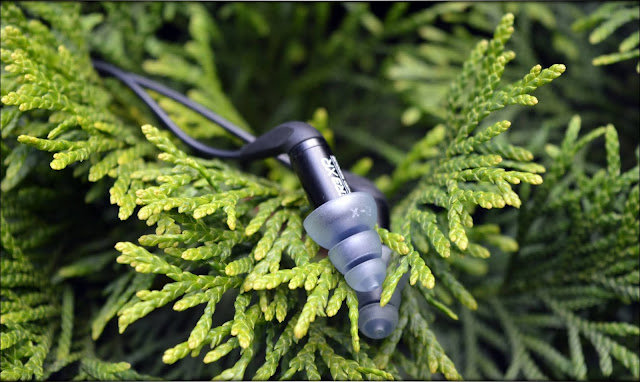Link to my review and measurement index thread where one can also find a full review overview, more information about myself as well as my general-ish audio and review manifesto: https://www.head-fi.org/threads/956208/
I only give full stars. My ranking/scoring system does not necessarily follow the norm and is about as follows:
5 stars: The product is very good and received the "highly recommended" award from me.
4 stars: The product is very good and received the "recommended" award from me.
3 stars: The product is good/very good, but not outstanding/special enough to get any of my two awards. ["Thumbs Up"]
2 stars: The product is only about average or even somewhat below that and somewhat flawed/flawed in some areas. [neither "Thumbs Up" nor "Thumbs Down"]
1 star: The product is bad/severely flawed to outright bad. ["Thumbs Down"]
Etymotic ER3XR
Source:
Review sample.
Miscellaneous:
Just like on the ER2XR as well as ER4XR, “XR” stands for “Extended Response”, indicating a moderately boosted bass compared to the flatter tuned SE (respectively SR) models.
The ER3 series IEMs are basically similar to the ER4 series, but with lower impedance and higher sensitivity (hence slightly different (darker) frequency response in stock form), different/less accessories (small instead of large carrying/storage case, shorter cable), manufactured at a different facility, don’t come with the new ER4 series’ “certificate of performance”, and, in theory, have less strict quality control/driver matching compared to the ER4 series, although even Etymotic stated that most ER3 units would easily pass ER4 series standards, but unlike on the more expensive, more pro-user targeted ER4 series, they couldn’t guarantee for this (at least in case of the ER3SE and ER3XR that I have on hand, I can say that these two would definitely and flawlessly pass ER4 series quality control and driver matching standards).
Come with the same accessories as the ER3SE and ER2 series (same small pouch case as that of my ER-4S and the ER3 series, one pair of green replacement filters along with a filter removal tool made of metal, one shirt clip, one pair of cylindrical foam tips, and last but not lest two pairs of differently sized silicone tips – that’s definitely a bit disappointing compared to the new ER4 series’ ampler amount of accessories, but overall still okay).
Small shells that are made of metal and similar to those of the ER4 series, however matte/satin black instead of stainless steel blue.
Build quality seems to be very good.
It’s nice that each shell has the serial number as well as model number on it in white (the same is true for the ER2 and new ER4 series in-ears).
Removable cables with non-rotating (small notch that prevents that) MMCX connectors.
Y-splitter that’s made of metal, too.
A chin-slider is present.
Cable shorter than the one that comes with the ER4 series in-ears and with straight instead of twisted conductors above the y-splitters.
Side indicators unfortunately only small and difficult to see in dimly lit environments – coloured indicators would have been better.
Fairly supple and flexible cable.
Rather high microphonics when worn down, but that can be fixed by guiding the cable over the ears and using the chin-slider (or alternatively using the included shirt clip).
One Balanced Armature driver per side.

Sound:
Largest included triple-flange silicone tips, modified so that they create a seal in my large ear canals while still maintaining the original ear tip length (achieved by cutting off the smallest flange and putting it onto the nozzle first, followed by the remaining double-flange rest of the tip).
Tonality:
Gentle bass elevation with fairly diffuse-field-oriented (but slightly milder) midrange and treble neutrality.
Basically just like the ER4XR, albeit ultimately slightly warmer in the fundamental range and slightly darker in the treble.
Flat and neutral midrange and treble along with a bass elevation that starts in the middle root around 600 Hz and climbs gradually towards the midbass and sub-bass where the highest quantity with about 4.5 dB higher level compared to the ER4SR is reached. Therefore the lows carry a mild warmth without really adding any colouration to the midrange yet.
Performing sine sweeps and listening to music, the midrange and treble sound very flat and even to me, which is something that is rare and achieved by only very few in-ears wherefore the ER3XR, just like the ER2 and ER4 series models, also sound highly realistic. Solely the 7 kHz area features a moderate recession to my ears, but this is something that is not really audible when listening to music.
Compared to absolutely uncompromised flat neutral, the highs are generally slightly but evenly in the background by around 2.5 dB, which is why the ER3XR sound a little darker and more relaxed/less “uncompromised lifeless neutral” in the highs when compared to the ER4SR or my ER-4S.
Frequency Response:

ER-4S-Compensation
The ER3XR were measured with the non-modified triple-flange ear tips in both graphs as I did not save the other measurements and didn’t bother to re-measure them. Due to the resulting slightly different insertion depth into the coupler, the graphs shows a bit less upper treble quantity than the ER3XR would actually have.

ProPhile 8-Compensation
Resolution:
One could assume that the ER3XR are inferior to the ER4 series in-ears, while in fact they are not and actually perform equally well.
The ER3XR also offer very good speech intelligibility and are capable of rendering small details very well wherefore they sound transparent and are among the very best single-BA in-ears that I know.
Separation of single notes in the high frequency range is precise.
The bass is fast as well as tight; solely fast and complex passages lead to it becoming slightly less clean sounding while separation remains intact and while it doesn’t appear soft yet.
While the resolution, transparency and headroom of some more expensive multi-BA in-ears isn’t reached by the ER3XR, they are nonetheless among the most capable single-BA models on the market and generally don’t need to fear most good multi-BA in-ears in the 500$ range either.
Soundstage:
The ER3XRs’ soundstage is neither the smallest nor the largest, but represents average dimensions and appears a little wider than deep to my ears, yet has a good amount of spatial depth and is well-layered. This makes the imaginary soundstage appear realistic and, in particular, coherent to the listener.
The placement of instruments (imaging) is very precise and spatial smear/blur is avoided, although the ER3SE perform even a tad better in a direct comparison.
- - - - - - - - - - - -
Comparisons:
Etymotic ER4XR:
The tonal differences between the ER3XR and ER4XR are less pronounced than between the ER3SE and ER4SR (at least when it comes to the units that I have on hand), which is why the ER3XR and ER4XR could be described as almost identical since the tonal differences between the two in-ears are about as small as the channel matching differences between in-ears of most other manufacturers are (and hereby I’m not referring to clearly mismatched models but rather in-ears that measure with a really, really tight channel matching).
That said, in the mid- and low bass, both in-ears’ tuning is the same. Only in the upper bass and fundamental range, the ER3XR have got a little more warmth and impact in comparison.
The ER3XR are only slightly less present in the presence area/upper mids than the ER4XR.
Solely around 6 and 7 kHz, there is a “more obvious” difference between the two: the ER3XR are a bit more relaxed here.
In the upper highs, the ER3XR are again a little more relaxed which can be heard in the reproduction of cymbals, although only slightly.
As a result, I consider the ER3XR the “better” alternative to the ER4XR due to their virtually similar resolution performance and only small tonal differences – solely for users who intend to use the in-ears for actual music production, the higher price for the ER4XR could still be worth it in the end because of their ultimately ever so slightly higher flatness/accuracy in the fundamental range and upper frequencies, provided that what one is looking for is a set of in-ears with a compensation for the viscerally perceived mechanical vibrations in the lows, which the XR models somewhat compensate for with their mild bass elevation compared to the SR/S/SE models that are tuned for an uncompromised flat neutral bass output without any tuning compensation for the lack of perceived mechanical vibrations that are absent on headphones and in-ears when compared to speakers in a room, but in the end that’s definitely a matter of personal perception/preference and how easily one’s brain can adapt to that “lack” when using headphones/in-ears (mine does easily).
So, to summarise, the ER3XR, compared to the ER4XR, are slightly warmer in the fundamental range, and slightly darker in the treble, but otherwise similarly tuned.
When it comes to details and resolution, both in-ears perform on an equal level – the absolutely only difference in a direct comparison is that the ER3XR appear minimally softer in bass, but this impression disappears when one lowers their lower fundamental range and upper bass slightly, which brings them exactly to ER4XR levels in this area.
Both in-ears’ imaging is equally precise and realistic, with equally good layering and separation of the imaginary events.
The ER4XR seem to have slightly more perceived spatial width, but this impression comes only from their slightly louder upper treble compared to the ER3XR.

Conclusion:
Highly Recommended.
Generally great sounding and superbly tuned (smooth neutral, even and very realistic with mild bass elevation) single-BA in-ears with high technical capabilities.
I even consider the ER3XR the better/more reasonable alternative to the ER4XR as long as one doesn’t need the slightly higher midrange and treble accuracy (in stock form), more/better accessories and cable, and individually hand-matched drivers that are accompanied by a channel matching/performance certificate.
Photos:

I only give full stars. My ranking/scoring system does not necessarily follow the norm and is about as follows:
5 stars: The product is very good and received the "highly recommended" award from me.
4 stars: The product is very good and received the "recommended" award from me.
3 stars: The product is good/very good, but not outstanding/special enough to get any of my two awards. ["Thumbs Up"]
2 stars: The product is only about average or even somewhat below that and somewhat flawed/flawed in some areas. [neither "Thumbs Up" nor "Thumbs Down"]
1 star: The product is bad/severely flawed to outright bad. ["Thumbs Down"]
Etymotic ER3XR
Source:
Review sample.
Miscellaneous:
Just like on the ER2XR as well as ER4XR, “XR” stands for “Extended Response”, indicating a moderately boosted bass compared to the flatter tuned SE (respectively SR) models.
The ER3 series IEMs are basically similar to the ER4 series, but with lower impedance and higher sensitivity (hence slightly different (darker) frequency response in stock form), different/less accessories (small instead of large carrying/storage case, shorter cable), manufactured at a different facility, don’t come with the new ER4 series’ “certificate of performance”, and, in theory, have less strict quality control/driver matching compared to the ER4 series, although even Etymotic stated that most ER3 units would easily pass ER4 series standards, but unlike on the more expensive, more pro-user targeted ER4 series, they couldn’t guarantee for this (at least in case of the ER3SE and ER3XR that I have on hand, I can say that these two would definitely and flawlessly pass ER4 series quality control and driver matching standards).
Come with the same accessories as the ER3SE and ER2 series (same small pouch case as that of my ER-4S and the ER3 series, one pair of green replacement filters along with a filter removal tool made of metal, one shirt clip, one pair of cylindrical foam tips, and last but not lest two pairs of differently sized silicone tips – that’s definitely a bit disappointing compared to the new ER4 series’ ampler amount of accessories, but overall still okay).
Small shells that are made of metal and similar to those of the ER4 series, however matte/satin black instead of stainless steel blue.
Build quality seems to be very good.
It’s nice that each shell has the serial number as well as model number on it in white (the same is true for the ER2 and new ER4 series in-ears).
Removable cables with non-rotating (small notch that prevents that) MMCX connectors.
Y-splitter that’s made of metal, too.
A chin-slider is present.
Cable shorter than the one that comes with the ER4 series in-ears and with straight instead of twisted conductors above the y-splitters.
Side indicators unfortunately only small and difficult to see in dimly lit environments – coloured indicators would have been better.
Fairly supple and flexible cable.
Rather high microphonics when worn down, but that can be fixed by guiding the cable over the ears and using the chin-slider (or alternatively using the included shirt clip).
One Balanced Armature driver per side.
Sound:
Largest included triple-flange silicone tips, modified so that they create a seal in my large ear canals while still maintaining the original ear tip length (achieved by cutting off the smallest flange and putting it onto the nozzle first, followed by the remaining double-flange rest of the tip).
Tonality:
Gentle bass elevation with fairly diffuse-field-oriented (but slightly milder) midrange and treble neutrality.
Basically just like the ER4XR, albeit ultimately slightly warmer in the fundamental range and slightly darker in the treble.
Flat and neutral midrange and treble along with a bass elevation that starts in the middle root around 600 Hz and climbs gradually towards the midbass and sub-bass where the highest quantity with about 4.5 dB higher level compared to the ER4SR is reached. Therefore the lows carry a mild warmth without really adding any colouration to the midrange yet.
Performing sine sweeps and listening to music, the midrange and treble sound very flat and even to me, which is something that is rare and achieved by only very few in-ears wherefore the ER3XR, just like the ER2 and ER4 series models, also sound highly realistic. Solely the 7 kHz area features a moderate recession to my ears, but this is something that is not really audible when listening to music.
Compared to absolutely uncompromised flat neutral, the highs are generally slightly but evenly in the background by around 2.5 dB, which is why the ER3XR sound a little darker and more relaxed/less “uncompromised lifeless neutral” in the highs when compared to the ER4SR or my ER-4S.
Frequency Response:
ER-4S-Compensation
The ER3XR were measured with the non-modified triple-flange ear tips in both graphs as I did not save the other measurements and didn’t bother to re-measure them. Due to the resulting slightly different insertion depth into the coupler, the graphs shows a bit less upper treble quantity than the ER3XR would actually have.
ProPhile 8-Compensation
Resolution:
One could assume that the ER3XR are inferior to the ER4 series in-ears, while in fact they are not and actually perform equally well.
The ER3XR also offer very good speech intelligibility and are capable of rendering small details very well wherefore they sound transparent and are among the very best single-BA in-ears that I know.
Separation of single notes in the high frequency range is precise.
The bass is fast as well as tight; solely fast and complex passages lead to it becoming slightly less clean sounding while separation remains intact and while it doesn’t appear soft yet.
While the resolution, transparency and headroom of some more expensive multi-BA in-ears isn’t reached by the ER3XR, they are nonetheless among the most capable single-BA models on the market and generally don’t need to fear most good multi-BA in-ears in the 500$ range either.
Soundstage:
The ER3XRs’ soundstage is neither the smallest nor the largest, but represents average dimensions and appears a little wider than deep to my ears, yet has a good amount of spatial depth and is well-layered. This makes the imaginary soundstage appear realistic and, in particular, coherent to the listener.
The placement of instruments (imaging) is very precise and spatial smear/blur is avoided, although the ER3SE perform even a tad better in a direct comparison.
- - - - - - - - - - - -
Comparisons:
Etymotic ER4XR:
The tonal differences between the ER3XR and ER4XR are less pronounced than between the ER3SE and ER4SR (at least when it comes to the units that I have on hand), which is why the ER3XR and ER4XR could be described as almost identical since the tonal differences between the two in-ears are about as small as the channel matching differences between in-ears of most other manufacturers are (and hereby I’m not referring to clearly mismatched models but rather in-ears that measure with a really, really tight channel matching).
That said, in the mid- and low bass, both in-ears’ tuning is the same. Only in the upper bass and fundamental range, the ER3XR have got a little more warmth and impact in comparison.
The ER3XR are only slightly less present in the presence area/upper mids than the ER4XR.
Solely around 6 and 7 kHz, there is a “more obvious” difference between the two: the ER3XR are a bit more relaxed here.
In the upper highs, the ER3XR are again a little more relaxed which can be heard in the reproduction of cymbals, although only slightly.
As a result, I consider the ER3XR the “better” alternative to the ER4XR due to their virtually similar resolution performance and only small tonal differences – solely for users who intend to use the in-ears for actual music production, the higher price for the ER4XR could still be worth it in the end because of their ultimately ever so slightly higher flatness/accuracy in the fundamental range and upper frequencies, provided that what one is looking for is a set of in-ears with a compensation for the viscerally perceived mechanical vibrations in the lows, which the XR models somewhat compensate for with their mild bass elevation compared to the SR/S/SE models that are tuned for an uncompromised flat neutral bass output without any tuning compensation for the lack of perceived mechanical vibrations that are absent on headphones and in-ears when compared to speakers in a room, but in the end that’s definitely a matter of personal perception/preference and how easily one’s brain can adapt to that “lack” when using headphones/in-ears (mine does easily).
So, to summarise, the ER3XR, compared to the ER4XR, are slightly warmer in the fundamental range, and slightly darker in the treble, but otherwise similarly tuned.
When it comes to details and resolution, both in-ears perform on an equal level – the absolutely only difference in a direct comparison is that the ER3XR appear minimally softer in bass, but this impression disappears when one lowers their lower fundamental range and upper bass slightly, which brings them exactly to ER4XR levels in this area.
Both in-ears’ imaging is equally precise and realistic, with equally good layering and separation of the imaginary events.
The ER4XR seem to have slightly more perceived spatial width, but this impression comes only from their slightly louder upper treble compared to the ER3XR.
Conclusion:
Highly Recommended.
Generally great sounding and superbly tuned (smooth neutral, even and very realistic with mild bass elevation) single-BA in-ears with high technical capabilities.
I even consider the ER3XR the better/more reasonable alternative to the ER4XR as long as one doesn’t need the slightly higher midrange and treble accuracy (in stock form), more/better accessories and cable, and individually hand-matched drivers that are accompanied by a channel matching/performance certificate.
Photos:











































